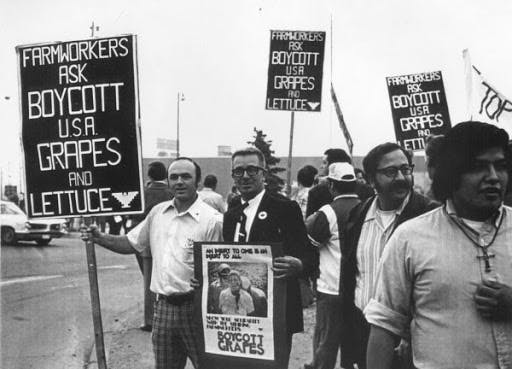Art as Protest: Images from the United Farm Workers of America, 1973–1978
Use this primary source imagery to analyze major events in history.
Suggested Sequencing
- Use this Primary Source with the César Chávez, Dolores Huerta, and the United Farm Workers Narrative while talking about the Latinx, women’s, Native American, and LGBTQ civil rights movements occurring during the 1970s.
Introduction
Migrant workers provided an important source of labor for agriculture in the California and the Southwest. Many of these workers were exposed to harmful pesticides, were poorly paid, and spent their lives in poverty. Efforts at striking or organizing prior to the 1960s were largely unsuccessful because the workers could not unionize and the growers were able to bring in other groups to harvest and break any strike. In 1962, Cesar Chavez, himself a former migrant worker, helped found the National Farm Workers Association, which later became known as the United Farm Workers (UFW). Chavez believed in the use of nonviolence and studied the tactics of Mohandas Gandhi and Dr. Martin Luther King Jr. Over the next few decades, Chavez organized several strikes, marches, and boycotts to protest conditions for farm workers and bring attention to their cause. His supporters created a variety of images during boycotts to encourage Americans not to purchase farm products in order to pressure growers to agree to the UFW’s demands. Chavez’s famous saying, “Sí se puede” (“Yes we can”), helped galvanize his supporters and is still used by activists today.
Sourcing Questions
- Who created these images?
- Why might images have a stronger effect on the audience than text would?

Figure 1: a 1965 United Farm Workers poster showing the organization’s logo: a black stylized eagle with wings shaped like an inverted Aztec pyramid.

Figure 2: A 1973 poster by artist Xavier Viramontes in support of the United Farm Workers Union. (credit: Xavier Viramontes, Boycott Grapes, Support the United Farm Workers Union, 1973, offset lithograph on paper, Smithsonian American Art Museum, Gift of Tomás Ybarra-Frausto, 1995.50.58, © 1973, Xavier Viramontes)
Comprehension Questions
- (Figure 2) Describe the imagery in the second poster. Why do you think it was portrayed that way?
- (Figure 1) (Figure 2) What similarities and differences do you notice between the two images?
Historical Reasoning Questions
- César Chávez encouraged his supporters to use nonviolent methods to achieve their goals. Why do you think he did this?
- Consider the UFW’s encouragement of boycotts of farm products to achieve a goal. What are some modern examples of boycotts of products to achieve something?
Image 1 https://www.loc.gov/item/2015649388/
Image 2 https://americanart.si.edu/artwork/boycott-grapes-support-united-farm-workers-union-34738
